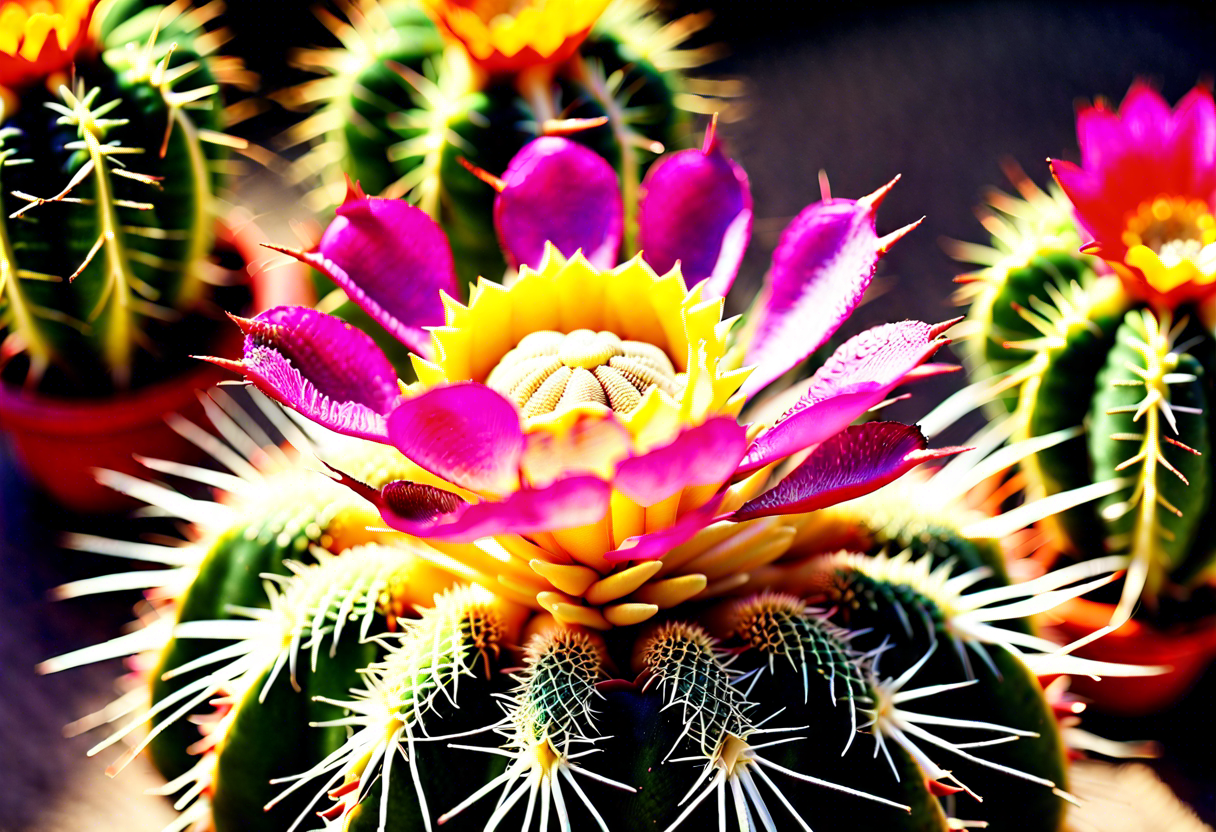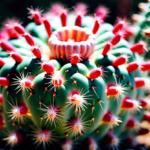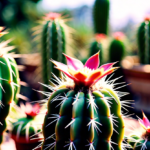Maximizing the Benefits of Growing Peanut Cactus (Echinopsis chamaecereus)
When it comes to indoor plants, the Peanut Cactus, scientifically known as Echinopsis chamaecereus, stands out as a popular choice among plant enthusiasts. This cactus species, native to South America, offers a myriad of benefits that make it an excellent addition to any indoor garden or collection.
One of the key advantages of growing Peanut Cactus is its low maintenance requirements. This resilient plant thrives in a variety of indoor environments, making it perfect for busy individuals or those new to plant care. With minimal watering needs and a preference for bright, indirect sunlight, the Peanut Cactus is a hassle-free plant that can brighten up any room.
In addition to being easy to care for, the Peanut Cactus is also known for its unique aesthetic appeal. Its distinctive cylindrical stems, which resemble peanuts or small potatoes, add a touch of charm and character to any space. Whether displayed on a windowsill, shelf, or desk, the Peanut Cactus is sure to be a conversation starter and a focal point in your home décor.
Furthermore, growing Peanut Cactus can have positive effects on your indoor air quality. Like all cactus species, the Peanut Cactus absorbs carbon dioxide and releases oxygen during the night, making it an ideal plant for bedrooms or other indoor areas where air circulation may be limited. Having a few Peanut Cactus plants scattered throughout your home can help freshen the air and create a healthier living environment.
Cultivating Peanut Cactus can be a rewarding experience for plant lovers of all skill levels. Watching this resilient plant grow and flourish under your care can bring a sense of accomplishment and joy. Whether you are a seasoned gardener or a beginner looking to enhance your green thumb, the Peanut Cactus is a versatile plant that is sure to bring satisfaction and beauty to your indoor garden.
The Peanut Cactus (Echinopsis chamaecereus) is a delightful plant that offers numerous benefits for indoor gardening enthusiasts. From its easy maintenance and aesthetic appeal to its air-purifying qualities and rewarding growth process, this charming cactus is a must-have addition to any indoor plant collection. Discover the joys of growing Peanut Cactus today and reap the many benefits it has to offer!
Tips for Caring for Peanut Cactus Indoors
As a proud owner of the Peanut Cactus (Echinopsis chamaecereus), it’s essential to understand the proper care techniques to ensure its health and longevity in an indoor environment. Here are some valuable tips to help you nurture your Peanut Cactus effectively:
- Light: Place your Peanut Cactus in a bright location with direct sunlight for a minimum of 6 hours daily. If natural light is scarce, supplement with a grow light to maintain its vibrant color and health.
- Temperature: Peanut Cacti thrive in warm to hot temperatures. Keep your plant in an area where the temperature stays between 70-100°F (21-38°C). Avoid sudden temperature drops to prevent damage to the cactus.
- Watering: Allow the soil to dry out completely between waterings. Overwatering can lead to root rot, so water sparingly, especially during the dormant winter months.
- Soil: Plant your Peanut Cactus in a well-draining cactus mix to prevent waterlogged roots. You can also mix in some perlite or sand to improve drainage.
- Fertilization: During the active growing season in spring and summer, feed your Peanut Cactus with a diluted cactus fertilizer every 4-6 weeks. Avoid fertilizing in the winter months when the plant is dormant.
- Pruning: Remove any dead or decaying parts of the cactus to promote healthy growth. Use sterile pruning tools to prevent the spread of diseases.
- Pests and Diseases: Keep an eye out for common pests like spider mites and mealybugs. Treat any infestations promptly with insecticidal soap or neem oil to protect your plant.
By following these care tips diligently, you can create a favorable environment for your Peanut Cactus to thrive indoors. Remember that each plant is unique, so observe how your cactus responds to adjustments in care and tailor your routine accordingly.
For more detailed information on caring for your Peanut Cactus, visit The Spruce.
Benefits of Growing Peanut Cactus (Echinopsis chamaecereus)
Peanut Cactus, scientifically known as Echinopsis chamaecereus, is a delightful succulent plant that can bring a touch of the desert into your home. Known for its unique peanut-shaped stems and vibrant blossoms, the Peanut Cactus is relatively easy to care for, making it a popular choice for both experienced gardeners and beginners alike.
One of the key benefits of growing Peanut Cactus is its ability to thrive in various conditions, including indoor settings. This makes it a versatile plant that can adapt to different environments, making it ideal for apartment dwellers or those with limited outdoor space.
Additionally, Peanut Cactus is known for its low maintenance requirements, making it a hassle-free addition to any plant collection. With proper care and attention, this resilient plant can provide years of beauty and enjoyment.
Another advantage of growing Peanut Cactus is its ability to brighten up any space with its stunning flowers. The plant typically blooms in spring or summer, producing an array of colorful flowers that can range from shades of red and orange to pink and yellow. These vibrant blooms can add a pop of color to your home and create a cheerful atmosphere.
Moreover, Peanut Cactus is also known for its air-purifying qualities, helping to improve the air quality in your home by removing toxins and releasing oxygen. This can contribute to a healthier indoor environment for you and your family.
The Peanut Cactus is a wonderful plant to grow for both its aesthetic appeal and its ease of care. With its resilience, colorful blooms, and air-purifying qualities, this charming succulent can enhance any indoor space and bring a touch of nature into your home.
For more information on growing and caring for Peanut Cactus, visit The Spruce.
Benefits of Growing Peanut Cactus (Echinopsis chamaecereus)
Peanut Cactus, scientifically known as Echinopsis chamaecereus, is a popular choice among plant enthusiasts due to its unique and striking appearance. This small cactus species is native to Argentina and boasts cylindrical stems that resemble peanuts, hence its common name. Growing Peanut Cactus in your home can bring numerous benefits, both aesthetic and practical.
One of the primary advantages of cultivating Peanut Cactus is its low maintenance requirements. This species is relatively easy to care for, making it an excellent option for novice gardeners or individuals with busy schedules. Peanut Cactus thrives in well-draining soil and requires minimal watering, making it an ideal choice for those who tend to forget about their plants or travel frequently.
Additionally, Peanut Cactus is known for its ability to purify the air in indoor spaces. Like all succulents, this cactus absorbs carbon dioxide and releases oxygen during the night, making it a great addition to bedrooms or other areas where improved air quality is desired. Its compact size also makes it suitable for small spaces such as desks, shelves, or windowsills.
Furthermore, growing Peanut Cactus can contribute to reducing stress and enhancing overall well-being. Studies have shown that caring for plants, even small ones like cacti, can have a positive impact on mental health by providing a sense of purpose and connection to nature. The unique appearance of Peanut Cactus, with its bright green stems and occasional blooms, can also bring joy and beauty to your living environment.
Incorporating Peanut Cactus (Echinopsis chamaecereus) into your indoor plant collection can offer a range of benefits, including easy maintenance, air purification, and improved well-being. Whether you are a seasoned plant lover or new to gardening, this charming cactus species is sure to brighten up your space and bring a touch of nature into your home.
For more information on caring for Peanut Cactus, you can visit The Spruce.
Propagation Methods for Peanut Cactus
Peanut Cactus (Echinopsis chamaecereus) is a popular succulent plant known for its unique appearance and ease of care. If you’re looking to expand your collection or share this beautiful plant with others, understanding the propagation methods for Peanut Cactus can be both rewarding and enjoyable.
1. Propagation by Offsets:
One of the simplest ways to propagate Peanut Cactus is by using offsets, also known as pups. These are small plantlets that grow around the base of the mature plant. To propagate using offsets, carefully remove them from the parent plant using a sharp, sterile knife. Allow the offsets to dry for a day or two to form a callus, then plant them in well-draining soil. Keep the soil slightly moist and place the new plants in a bright location, but away from direct sunlight until they establish roots.
2. Propagation by Stem Cuttings:
Another method to propagate Peanut Cactus is through stem cuttings. To do this, take a clean, sharp knife and cut a healthy stem from the parent plant. Allow the cutting to dry for a few days until the cut end calluses over. Plant the cutting in a well-draining cactus mix and place it in a warm, bright location. Water the cutting sparingly until roots develop, usually in a few weeks.
3. Propagation by Seeds:
For those looking for a more challenging but rewarding method, propagating Peanut Cactus from seeds is an option. Start by sowing seeds in a well-draining cactus mix and lightly cover them with soil. Keep the soil consistently moist but not waterlogged. Place the seeds in a warm location with indirect sunlight. With patience and proper care, the seeds will germinate, and you’ll soon have new Peanut Cactus seedlings.
4. Tips for Successful Propagation:
Regardless of the propagation method you choose, there are a few key tips to ensure successful propagation of Peanut Cactus. Firstly, always use well-draining soil to prevent root rot. Secondly, provide ample indirect sunlight to encourage healthy growth. avoid overwatering, as Peanut Cactus is drought-tolerant and is susceptible to root rot if left in damp soil for too long.
By exploring these propagation methods, you can expand your Peanut Cactus collection and share the beauty of this unique succulent with others. Whether you choose to propagate through offsets, stem cuttings, or seeds, each method offers a rewarding experience that allows you to witness the growth and development of these fascinating plants.
For further insights on Peanut Cactus propagation and care, visit gardeningwebsite.com.
Conclusion
The beautiful Peanut Cactus (Echinopsis chamaecereus) into your indoor space comes with a range of benefits. Not only does this unique succulent add a touch of natural charm to your home, but it also requires minimal care and maintenance. By following a few simple tips, such as providing adequate sunlight, watering sparingly, and using well-draining soil, you can ensure your Peanut Cactus thrives in an indoor environment.
When it comes to caring for your Peanut Cactus indoors, proper lighting is crucial. Place your cactus in a location where it can receive plenty of bright, indirect sunlight. Rotate the plant regularly to promote even growth on all sides. Additionally, water your cactus sparingly, allowing the soil to dry out completely between waterings to prevent root rot.
Despite being relatively low-maintenance, Peanut Cacti are susceptible to a few common pests and diseases. Keep an eye out for issues such as mealybugs, spider mites, and root rot. To combat these problems, consider using natural remedies like neem oil or insecticidal soap, and ensure your cactus is not overwatered to prevent fungal infections.
To add a touch of creativity to your home decor, explore different ways to display your Peanut Cactus. Consider placing them in unique containers like teacups, hanging them in macrame planters, or arranging them in a terrarium. These inventive displays can enhance the visual appeal of your space while showcasing the beauty of your cacti collection.
Propagation of Peanut Cactus is a rewarding experience that allows you to expand your cactus family. One common method of propagation is through offsets or pups that grow around the base of the plant. Simply remove these offsets and plant them in a separate container with well-draining soil to watch them grow into mature cacti. Another method is by seed, although this process requires more time and patience.
Growing Peanut Cactus (Echinopsis chamaecereus) indoors is a delightful way to bring a touch of nature into your home. By following the provided care tips, you can ensure your cactus remains healthy and vibrant. Be vigilant against pests and diseases, get creative with your display ideas, and explore propagation methods to expand your cactus collection. With the right care and attention, your Peanut Cactus will thrive and add a unique charm to your indoor space.


